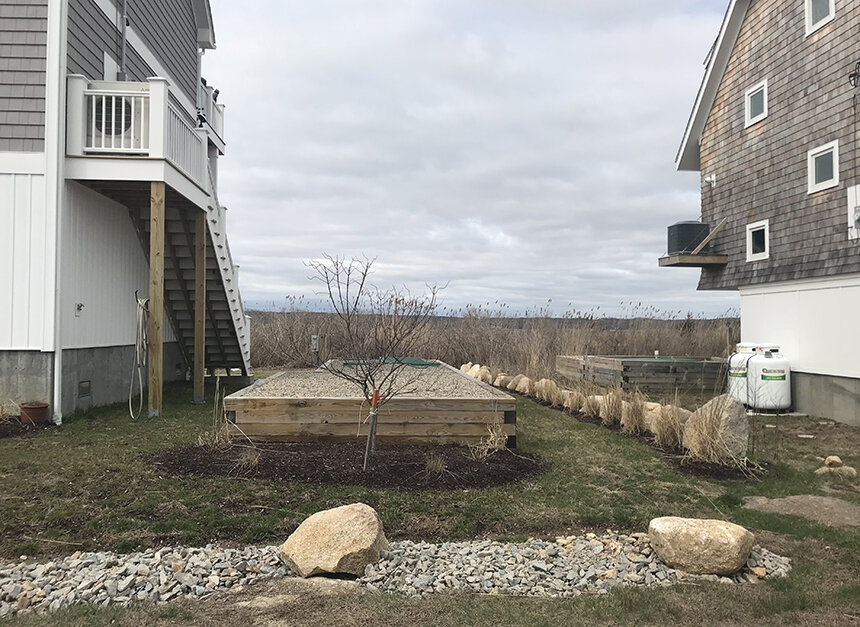5-year project will look to improve septic management and protect the watershed
By Todd McLeish
The town of Charlestown is
collaborating with University of Rhode Island wastewater management experts in
a pilot project to develop a comprehensive approach to reducing the amount of
nitrogen from septic systems that enters the groundwater and finds its way into
drinking water and the nearby salt ponds.
One of the alternative wastewater systems being studied in Charlestown.
Photo by Cynthia Drummond in her ecoRI article
The collaborators were awarded a
$750,000 five-year grant from the U.S. Environmental Protection Agency’s
Southeast New England Program to install, test and monitor a new
nitrogen-reducing septic technology, install stormwater mitigation measures,
develop a community education and engagement plan, and prepare a summary
document that will enable other communities to follow suit.
“The town of Charlestown has been
very proactive in its wastewater management and watershed management, and this
grant builds on the successful approaches that they’ve tried in the past,” said
Alissa Cox, director of the New England Onsite Wastewater Training Program at
URI, who will lead the project with Charlestown’s Onsite Wastewater Management
Program Director Matthew Dowling.
According to Cox, septic systems in coastal communities like Charlestown can have a negative impact on groundwater, drinking water and public health. When nitrogen makes its way into groundwater, it can impair drinking water quality and create algal blooms in salt ponds that can lead to low oxygen levels and fish and shellfish kills.
“Many communities like Charlestown
throughout coastal New England rely on local groundwater for drinking water and
onsite septic systems for wastewater management,” said Dowling. “Unmanaged
systems and comingled septic plumes can impact not only drinking water quality
but also the coastal ecosystems that these communities depend on as a major
component of their economies. So, investing in septic system management
becomes a priority.”
The new septic technology will be
tested at up to 10 homes near the western end of Green Hill Pond and the
eastern end of Ninigret Pond. It is called a nitrogen-reducing layered soil
treatment area system, in which a septic system’s drain field consists of a
layer of sand over a layer of sand mixed with sawdust.
When septic effluent moves through
the layers, the sand layer converts the ammonium into nitrate-nitrogen and the
sand-and-sawdust layer converts the nitrate-nitrogen into a gas that dissipates
into the atmosphere instead of making its way into the groundwater.
Cox said this technology is far less
expensive than the proprietary technologies many companies are seeking to
install in similar places, some of which can cost up to $40,000.
“We’ve seen this layered soil
treatment system working in other parts of North America, especially Canada,
Florida and Cape Cod, and we’re trying to bring it to Rhode Island and other
parts of New England,” Cox said.
“Instead of using one of the
expensive proprietary systems, you can use this non-proprietary drain field to
reduce nitrogen. It’s another option homeowners can consider.”
URI’s role in the project is to
assist with the design, installation and monitoring of the new layered soil
treatment area systems and compare them to the performance of the more
expensive, proprietary systems installed elsewhere.
Other partners are Save The Bay,
which will install stormwater mitigation measures to reduce the impact of
stormwater runoff on the salt ponds, and the Salt Ponds Coalition, which will
conduct water quality monitoring to assess the impacts of the installations.
Cox and her colleagues will work
with all of the partners on the public education and engagement component of
the project.
“My vision is to create watershed celebration
days where we have a series of tours of the new layered systems and stormwater
management measures so people can see and learn more about them,” Cox said.
“It might be like a combined block
party and tour to engage the community. We’ll reach out to cultural and
historical representatives of the watershed to provide cultural perspective and
community engagement, along with other community groups, to make it more of a
celebration and to give folks an understanding of these new tools for
protecting the watershed.”
By the end of the five-year project,
Cox expects to have prepared a blueprint in collaboration with the town of
Charlestown for how other coastal communities with a large number of septic
systems can improve their watershed management while meeting regulatory
requirements.
“Our final report will be a case
study of our successes and the lessons we’ve learned so it can be used to train
other communities,” Cox said.